
Mason Bee vs Leafcutter Bee Illustration
Mason bees and leafcutter bees play vital roles in pollination with distinct behaviors and nesting habits. Mason bees use mud to construct their nests in natural cavities, promoting efficient pollination of fruit trees and flowering plants. Leafcutter bees, recognized by their unique leaf-cutting activity, create nests lined with leaf pieces, contributing to the pollination of various wildflowers and crops.
Table of Comparison
| Feature | Mason Bee | Leafcutter Bee |
|---|---|---|
| Pollination Efficiency | High, effective in fruit and berry crops | Moderate, good for alfalfa and wildflowers |
| Nesting Behavior | Uses natural cavities, seals with mud | Builds nests from leaf pieces |
| Lifespan | Several weeks in spring | Several weeks in summer |
| Active Season | Early spring to late spring | Mid to late summer |
| Flight Range | Up to 300 meters | Up to 200 meters |
| Pollination Target | Fruit trees, berries, vegetables | Alfalfa, wildflowers, shrubs |
| Habitat Preference | Gardens, orchards | Fields, wild areas |
| Colony Size | Solitary | Solitary |
| Growth Rate | Rapid, quick population build | Moderate |
Introduction to Mason Bees and Leafcutter Bees
Mason bees (Osmia spp.) are solitary pollinators known for their efficient springtime activity and preference for nesting in hollow stems or cavities sealed with mud. Leafcutter bees (Megachile spp.) are also solitary and gather leaf pieces to construct protective cells for their larvae, playing a crucial role in pollinating various flowering plants. Both species contribute significantly to agricultural ecosystems by enhancing fruit set and biodiversity through targeted pollination.
Key Differences in Appearance
Mason bees exhibit a robust body with metallic blue or green hues, while leafcutter bees tend to have a more cylindrical body with lighter, often orange or black coloring. Mason bees carry pollen on the hairs of their abdomen, contrasting with leafcutter bees that transport pollen on the underside of their abdomen. Leafcutter bees have strong mandibles adapted for cutting leaves, which is a distinctive physical trait compared to the smoother mandibles of mason bees.
Pollination Efficiency: Mason vs Leafcutter Bees
Mason bees exhibit higher pollination efficiency compared to leafcutter bees due to their methodical foraging behavior and preference for diverse floral resources. Leafcutter bees primarily target specific plant species, which can limit cross-pollination and genetic diversity in crops. Mason bees' ability to pollinate early blooming flowers effectively supports orchard productivity and enhances fruit set in a wider range of plants.
Nesting Habits and Preferences
Mason bees prefer to nest in hollow stems or wood cavities, where they use mud to partition their brood cells, creating a sturdy and protective environment for their larvae. Leafcutter bees, on the other hand, cut circular pieces of leaves to line their nests, often choosing tunnels in soft wood or soil to provide a smooth, insulated chamber for their offspring. Both species exhibit solitary nesting behavior but differ significantly in their material use and site selection, influencing their roles in various ecosystems and pollination efficiency.
Life Cycle Comparison
Mason bees complete their life cycle by nesting in pre-existing cavities, where females provision each cell with pollen and nectar before sealing it with mud; their development from egg to adult takes about 6 weeks. Leafcutter bees create nests in similar cavities but uniquely line each cell with circular leaf pieces, providing a secure environment for larvae that develop over approximately 3 to 4 weeks. Both species undergo complete metamorphosis with egg, larva, pupa, and adult stages, but their nesting materials and development durations distinguish their life cycles within pollinator ecosystems.
Ideal Plants for Mason and Leafcutter Bees
Mason bees thrive on early-blooming fruit trees like cherry, apple, and apricot, as well as flowering shrubs such as lilac and spiraea, which provide abundant nectar and pollen. Leafcutter bees favor plants with soft leaves for nesting materials, including rose, alfalfa, and hibiscus, alongside a diverse range of flowering plants like sunflowers and clovers that support their foraging needs. Both bee species contribute significantly to pollination in home gardens and orchards, enhancing fruit and seed production.
Benefits of Mason Bees in the Garden
Mason bees are highly efficient pollinators that increase fruit and vegetable yields by up to 40% due to their methodical foraging behavior and early spring activity. Their non-aggressive nature and ability to pollinate in cooler, wetter conditions make them ideal for diverse garden environments. Unlike leafcutter bees, mason bees contribute to soil health by nesting in natural cavities, promoting biodiversity and ecosystem balance.
Benefits of Leafcutter Bees in the Garden
Leafcutter bees enhance garden pollination by efficiently transferring pollen between flowers, promoting higher fruit and vegetable yields compared to Mason bees. Their preference for cutting leaves to build nests reduces pest damage by targeting specific plants without widespread harm. Leafcutter bees also exhibit resilience in diverse environments, making them a reliable pollinator for various garden ecosystems.
Managing and Supporting Native Bee Populations
Mason bees and leafcutter bees are vital native pollinators known for their efficient pollen transfer and solitary nesting habits, making them ideal for enhancing garden biodiversity. Managing these species involves providing specific nesting materials--mason bees require hollow tubes or wood cavities for mud-based nesting, while leafcutter bees use leaf fragments to build nests in narrow tunnels. Supporting their populations includes planting diverse native flowering plants to supply continuous pollen and nectar sources throughout the growing season, promoting healthy ecosystem pollination services.
Choosing the Right Bee for Your Garden
Mason bees and leafcutter bees both serve as efficient pollinators but differ in nesting habits and plant preferences. Mason bees prefer nesting in pre-existing holes and are excellent for fruit trees, while leafcutter bees use leaf fragments to build nests and are ideal for pollinating wildflowers and alfalfa. Selecting the right bee depends on your garden's vegetation and available nesting sites to maximize pollination success.
Mason Bee vs Leafcutter Bee Infographic

 gardendif.com
gardendif.com